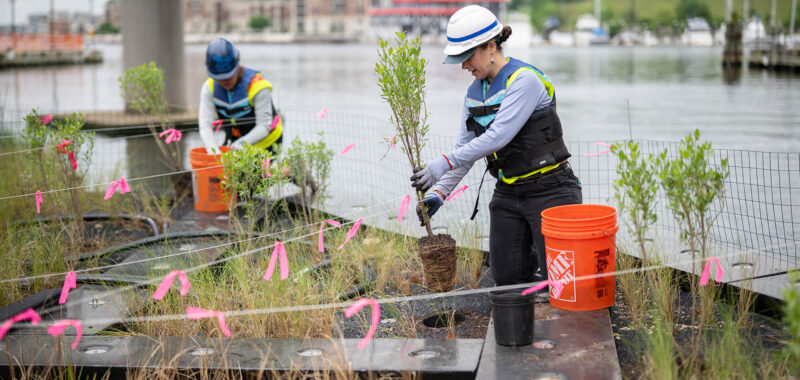In case you hadn’t noticed, Baltimore’s Inner Harbor is teeming with new development. This week, its newest feature, a 10,000-square-foot floating wetland by Ayers Saint Gross, opens to the public. The aquatic landscape will allow visitors to walk on water and learn about wildlife.
The National Aquarium Harbor Wetland was built between the harbor’s Piers 3 and 4. Its goal is to help transform Chesapeake Bay into a demonstration landscape, and create a new free exhibit for the public. Over 30,000 grasses and shrubs coalesce at the new wetland, combined with water aeration technology.
Visitors can get up close to the new plant life thanks to a new, serpentine pedestrian pier that juts out from the waterfront promenade. And after the plant life matures, it will help clean the bay’s waters, and attract native species. The pocket (water) park offers citizens of Baltimore an exciting new outdoor classroom.

Ayers Saint Gross first began working with the National Aquarium in 2016. That year, the institution hired Ayers Saint Gross for a new campus plan. Then after the campus plan was finished in 2018, Ayers Saint Gross; Biohabitats; McLaren Engineering Group; and Kovacs, Whitney & Associates revealed a new prototype that would enable plant life to grow on Baltimore’s Inner Harbor.
Walking on Water
Amelle Schultz, a principal at Ayers Saint Gross, was on the project from start to finish. “Earlier wetlands technology had this essential flaw in that, as the biomass grew, it would sink from its own weight over time,” Schultz told AN. “We had been studying this issue before the National Aquarium reached out to us for a new campus plan in 2016.”
“At the end of the planning process in 2018, it was obvious that everyone in the planning process was really excited about creating a new salt marsh in the bay,” Schultz continued. “We think this approach can be replicated at many other compromised waterfronts to improve environmental health in urban conditions. It’s a great way of connecting people to water, and educating the public about water and ecological issues.”

After years of hard work, the kicker for Schultz and her colleagues at Ayers Saint Gross came one evening when the wetlands had some visitors. “The icing on the cake was when National Aquarium security footage captured two river otters rolling around on the wetlands in the middle of the night,” Schultz said. “I think our team at the office hit replay on that video about ten times in a row. It was so cute.”
Since the wetlands have been installed, other animals like fish, ducks, dragonflies, and even Maryland blue crabs have paid a visit as well. “In Maryland, blue crabs are a big deal,” Schultz continued. “Seeing wild life return to Baltimore has been such an affirmation. There are species out there, not far from where we live, that just need a place to have as their own destination.”

